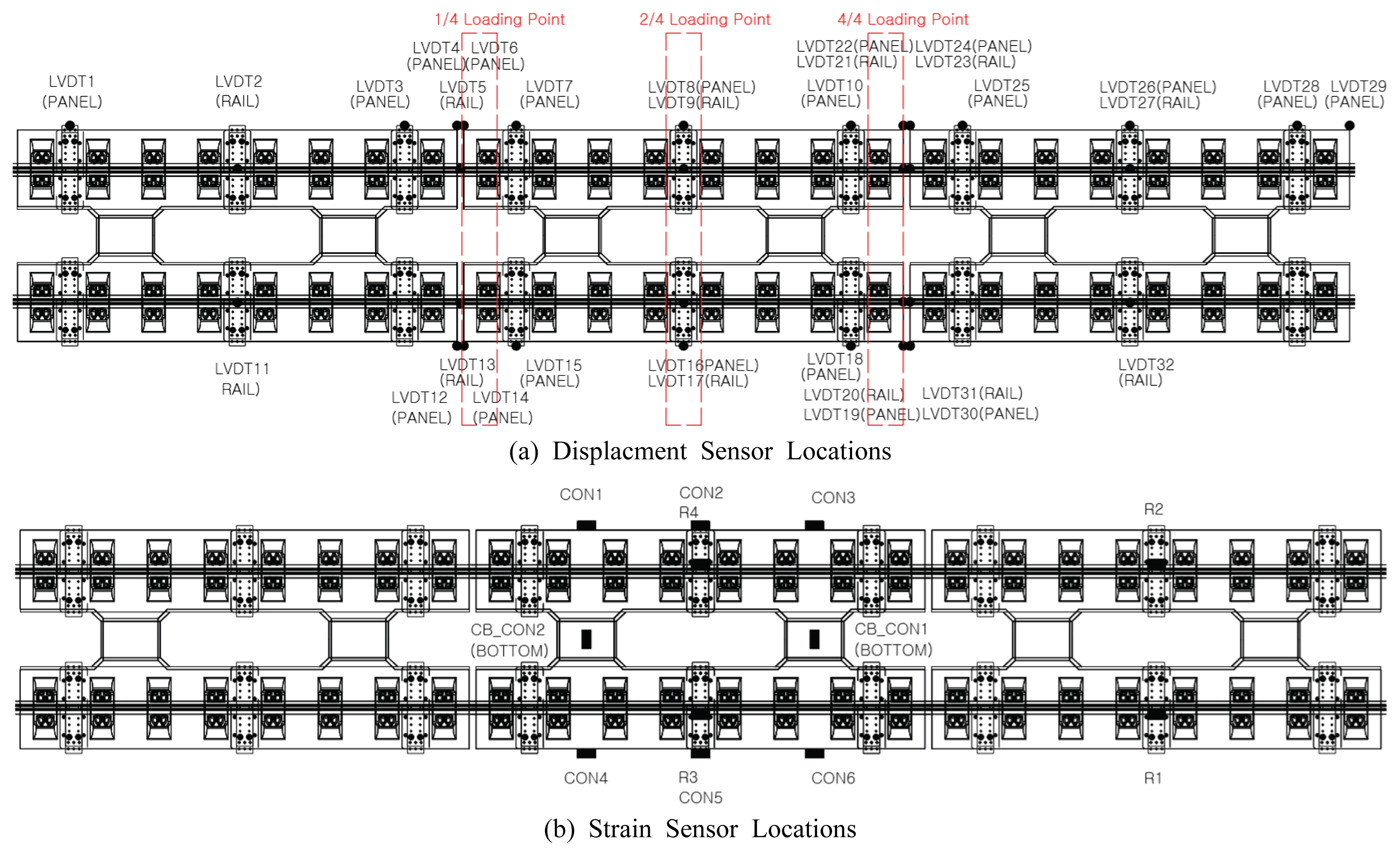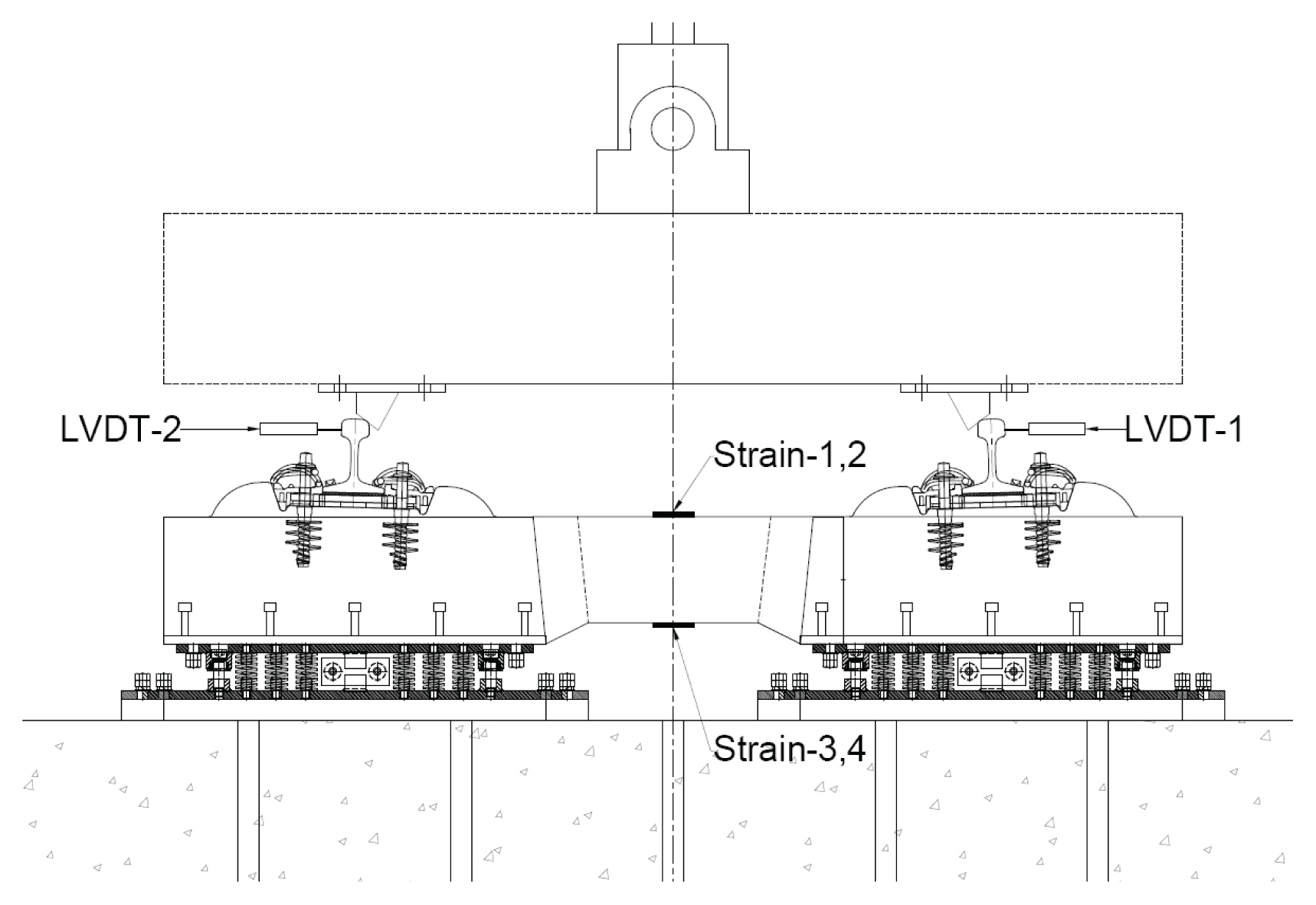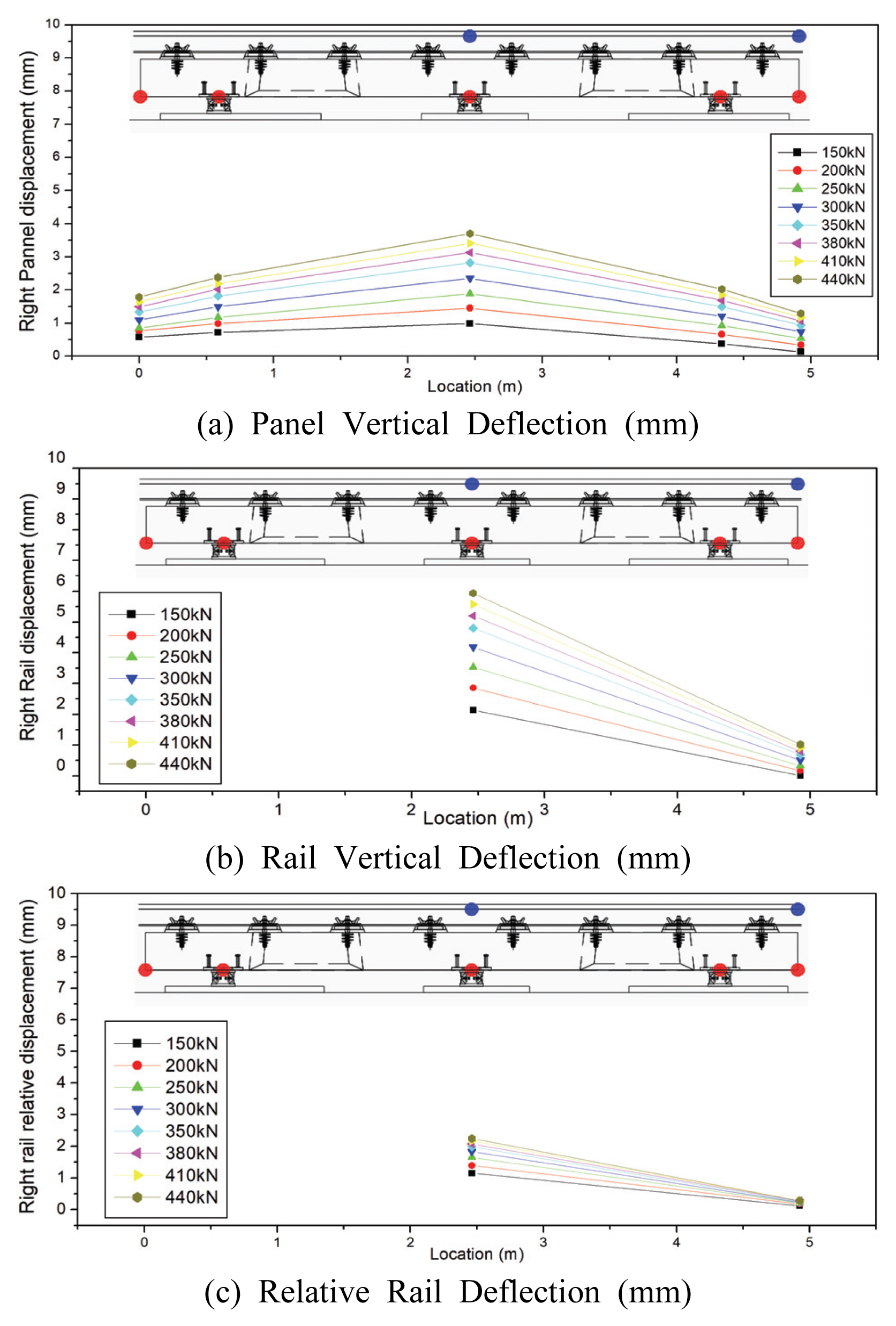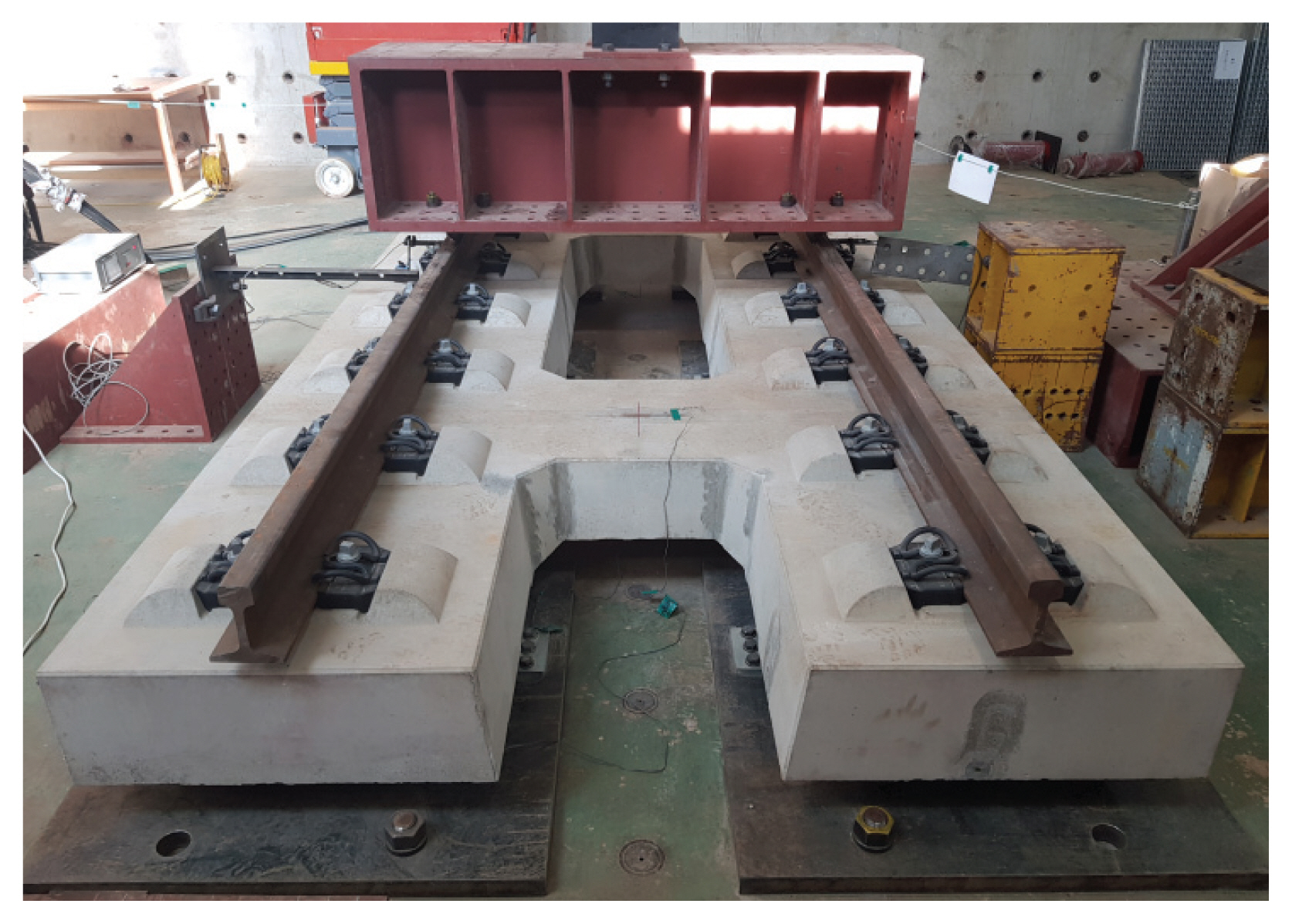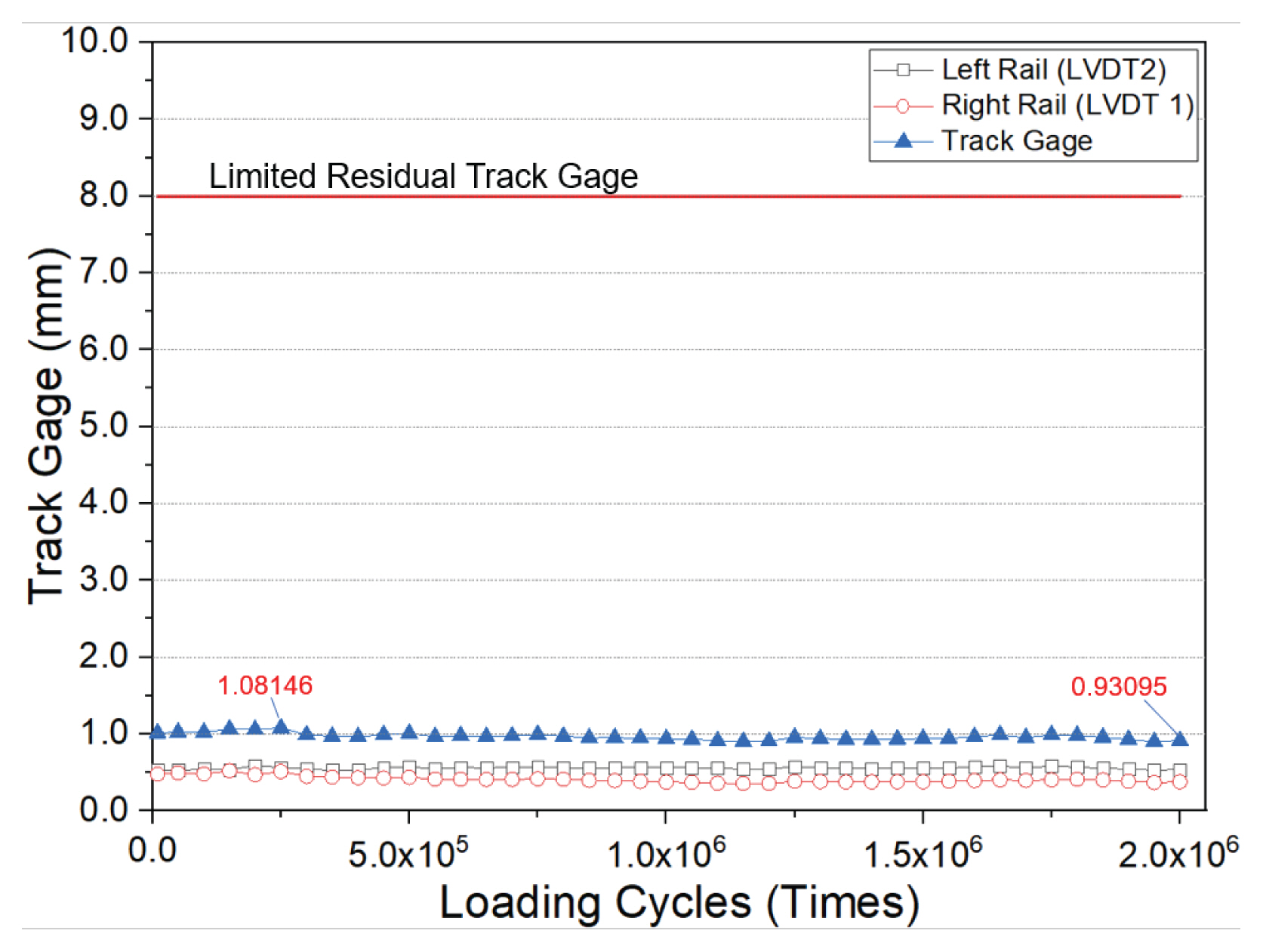 |
 |
- Search
| J. Korean Soc. Hazard Mitig. > Volume 19(5); 2019 > Article |
|
Abstract
To reduce railway vibration, prefabricated precast floating track along with an isolator for reducing vibration and noise was recently developed in Korea by removing existing gravel tracks within the required time without disturbing railway operations for station on the track, station below the track, and underground station sections. This study verifies the structural performance of the prefabricated precast floating track. To this end, three precast slab track panels with friction-type vibration isolators were fastened with rails for static and dynamic tests, and fatigue tests were conducted on one panel. The test results indicated that the rails and panels of the three-panel assembly test specimens satisfied the required performance. The floating track is considered to have sufficient structural safety.
요지
철도진동을 저감하기 위해서 선상, 선하, 지하 역사 구간을 대상으로 하여 철도운행의 지장 없이 기존역사 자갈궤도를 철거 후 제한시간내 설치하여 진동소음을 저감할 수 있는 방진장치가 부착된 사전제작형 플로팅 궤도(Prefabricated Precast Floating Track)가 최근 국내에서 개발되었다. 본 연구에서는 사전제작형 플로팅 궤도에 대한 구조적 성능을 검증하였다. 이를 위해 마찰형 방진장치가 부착된 프리캐스트 궤도 슬래브 패널 3개를 레일로 체결하여 정적 및 동적시험을 수행하고 1개 패널에 대해서는 피로시험을 수행하였다. 시험결과 3개 패널의 조립시험체의 레일과 패널은 요구성능을 만족하며 구조 안전성을 확보한 것으로 판단된다.
철도 운행시 철도 시설물에서 발생되는 진동과 소음은 시설 사용자의 안락함을 저해하며 직접적인 피해배상, 진동과 소음을 저감하기 위한 시설물의 공사비용(방진, 방음을 위한 공사비용) 및 유지보수 비용 등이 추가로 발생된다. 전 세계적으로도 소음, 진동 분쟁 발생될 때 배상 청구의 근거가 되는 법적 기준과 책임이 강화되는 추세이어서 철도 신선 및 기존선 시설의 건설과 운영시 진동과 소음을 저감하기 위한 대책 마련이 필요하다.
최근에는 철도 부지 확보가 어려워 철도 선로 시설물의 입체화가 진행되고 다양한 형태의 역사건설도 증가하고 있다. 이 중 선하역사는 선로하부의 공간을 활용도를 높여 역사를 설치하여 역사공간을 최소화하고 승객 동선의 효율성을 높일 수 있지만 인구가 밀집하는 역사 내에 정온시설과 사무 및 휴게공간의 사용이 점차 늘어나서 진동저감 대책의 중요성이 커지고 있다(Kwon and Kim, 2018).
역사에서는 운행하는 열차의 동적 하중이 레일, 궤도 슬래브가 이를 지지하는 바닥 슬래브를 통해 역사의 골조를 이루는 구조재인 기둥, 슬래브, 벽체 등에 전달된다(Yang et al., 2000). 이로 인하여 역사 내의 슬래브에 구조전달음(Structure Born Noise)이 발생하여 2차 소음 피해가 발생할 수 있다(Esveld, 2001). 기존 역사의 소음‧진동 저감 대책은 발생원, 전달경로 및 응답원 별로 대책 수립이 가능하지만, 역사 구조물과 같은 명확한 발생원에는 발생 가진원에 대한 대책을 수립하는 것이 저감효과와 경제성 측면에서 효과적이다(Yang et al., 2004).
발생원 대책 중 하나로 차륜-레일에서 발생하는 하중을 하부 구조물과 격리시켜 전달되는 하중의 크기를 줄이고 진동을 제어하는 플로팅 궤도는 국내 및 해외에 시공사례가 있다(Kang et al., 2012). 그러나 대부분의 기술이 현장타설식 공법을 적용하여 신설역사에는 적용이 가능하나, 열차운행 중단이 곤란한 운영선상에서 상당한 공사 기간동안 운행선을 완전 차단하여 열차가 운행을 하지 못하므로 도심지를 통과하는 일반 및 도시철도의 경우는 공법적용이 사실상 불가능하다고 판단된다.
본 연구에서는 이를 해결하고자 공장에서 사전제작하여 현장으로 운송, 설치하는 사전제작형 플로팅 궤도 시스템에 대한 연구를 수행하였다. 본 연구에서는 개발 궤도의 성능검증을 위한 조립성능시험 결과를 분석하고자 한다.
사전제작형 플로팅궤도 궤도(Precast Floating Track)는 철도진동을 저감하기 위해서 선상, 선하, 지하 역사 구간을 대상으로 하여 철도운행의 지장 없이 급속시공이 가능하다.
기존역사 자갈궤도를 철거 후 제한시간내 설치가 가능하도록 개발된 사전제작 플로팅 궤도는 4.925 m 길이의 프리캐스트 궤도패널 1개 패널 하부에 6개의 방진장치가 부착되어 있다. 패널은 서로 가로바(Cross Bar)로 연결된 조립블럭으로 구성되어 있고 급속시공을 위해서 시공현장으로 운반하여 미리 정거장 슬래브 상부에 정렬하여 고정된 궤도 높이조절용 받침부에 조립 체결한다. 패널은 유압 잭(Hydraulic Jack) 등으로 인상(Lifting)을 한 후에 정밀측량을 통해 고저정정을 실시하고, 평탄한 상태에서 플로팅궤도 시스템을 순차적으로 부설한다. 설치되는 마찰형 댐퍼식 방진장치는 쐐기형 Engineering Plastic (EP) 블록을 도입하여 마찰저항을 통해 연직방향의 진동을 감쇠시키고 수평 및 수직 방향으로 배치한 코일스프링을 통하여 복원력을 제공하여 진동을 절연시킨다.
열차주행시 발생되는 패널의 진동은 Fig. 1의 (a)와 같이 차륜의 레일 접촉점에서 레일 및 체결장치, 궤도 패널, 방진장치, 역사구조물로 순차적으로 전달되는데, 질량-스프링 시스템(Mass-Spring System, MSS) 시스템의 질량과 방진장치의 이력거동, 감쇄를 통해 진동이 저감된다(Wagner, 2002).
사전제작형 플로팅 궤도는 그 성능평가를 위해 구성품시험과 구성재료시험 및 조립시험 단계를 거친다. 본 논문에서는 조립시험 단계중 수행한 정하중시험, 동적하중시험 및 피로시험을 수행한 결과를 나타낸다. 평가한 시험항목은 Table 1과 같다.
사전제작 프리캐스트 패널을 구성하는 레일, 슬래브 패널, 방진장치가 결합되어 구성된 궤도시스템의 거동을 평가하기 위하여 조립시험체에 대한 정적하중시험을 수행하였다. 각각의 하중재하점은 2번 패널 1/4지점, 2번 패널 2/4지점, 2번 패널 단부에 재하를 하였는데 단일 슬래브 시험체는 Fig. 3에 나타내었다. 3개의 슬래브의 조립 시험체는 Fig. 4에 제시한 것과 같이 3개의 패널을 종방향으로 배치하고 하중을 가력하였다.
구제적인 플로팅 슬래브 궤도 패널의 제원은 Table 2와 같다. Figs. 2∼7까지는 시험센서 설치도를 나타낸다. Figs. 8∼10은 재하하중의 이력을 나타내는 하중선도이다. 정적하중 시험에서 Full scale 재하하중시험은 150, 200, 250, 300, 350, 380, 410, 440 kN으로 하중을 재하하였고 하중 가력속도(DIN 45673-1)는 2 kN/s이며 최대하중은 10 sec동안 지속하였다.
하중가력은 500 kN Dynamic Actuator를 사용하였으며 데이터 수집은 일본 동경측기사 제품인 TDS-601 데이터로거를 사용하였다. 변위측정 장비로는 50 mm, 100 mm 용량의 변위측정센서(LVDT)와 철근과 콘크리트의 변형률을 측정하기 위해서 변형률 게이지(Strain Gauge)를 사용하였다.
사전제작형 플로팅 슬래브 궤도의 1패널에 패널 중앙부에 하중을 재하시 패널의 수직변위를 나타낸 측정결과는 Table 5와 같다.
패널의 최대수직변위는 하중재하에 따라 증가하며 이를 나타낸 것은 Fig. 8의 (a)의 그래프와 같다. 정적하중을 150∼440 kN 재하할 때 패널에서는 중앙부 방진장치(Center Isolator)가 위치한 패널에서는 0.99 mm∼3.70 mm까지 패널 수직변위가 발생하였고, 측부 방진장치(Side Isolator)가 위치한 패널에서는 0.37 mm∼2.38 mm가 발생하였으며, 수직처짐 평균값은 0.69 mm∼2.70 mm 였다.
측정된 수직처짐으로 구한 방진장치 6개에 대한 지지강성(Support Stiffness)은 27.16∼36.06 kN/mm 로 이는 초기에 설계된 방진장치의 지지계수 값과 유사한 값이 측정되었다.
사전제작형 플로팅 슬래브 궤도의 1패널에 패널 중앙부에 하중을 재하시 레일의 상대변위 측정결과는 Table 6과 같다. 레일 최대변위는 Fig. 8과 같이 중앙점에서 발생하며 정적하중 150∼440 kN 재하시에 우측레일에서 1.22∼2.60 mm까지 레일 수직상대변위가 발생한다. 우측레일은 다소 작은 1.15∼2.24 mm의 레일 수직 상대변위가 발생하는데 좌우측 레일변위의 최대변위편차는 0.36 mm이내로 측정되었으며 이는 최대하중 대비 13.8%로 해당하는 값으로서 패널의 좌우측에 비교적 균일한 하중이 전달된 것으로 판단된다.
1패널 하중의 레일단부는 동일한 하중 재하시 좌측레일에서 0.11∼0.37 mm까지 레일 수직상대변위가 발생하며 우측레일은 다소 작은 0.12∼0.28 mm의 레일 수직변위가 발생한다. 1패널의 변위는 패널의 중앙부에서 단부측에 발생하는 변위에 비해 7.99배 정도로 크게 발생한다.
사전제작형 플로팅 슬래브 궤도의 3패널의 조립시험체는 3개의 패널을 거치하고 연속된 레일을 올려 놓은 후 이를 패널에 체결하여 조립시험체로 구성하여 하중을 재하 하였다. 가운데 패널 중앙부에 하중을 재하시 패널의 수직변위를 나타낸 측정결과는 Table 7과 같다.
Figs. 9∼11은 3개 패널로 구성된 조립시험체의 하중재하점의 변화될 때 발생되는 패널의 수직변위과 레일의 수직처짐 그리고 레일의 상대변위를 나타낸다. 좌측을 기준으로 하여 2번째 2/4지점(패널 중앙부와 일치)에 하중을 재하하였을 때 측정결과를 나타낸 것은 Fig. 9와 같다.
2번째 패널 4/4지점(패널 우측 단부와 일치)에 하중을 재하한 것은 Fig. 10과 같다. 2번째 패널 1/4지점(패널 좌측단부와 일치)에 하중을 재하한 측정결과는 Fig. 11에 나타나 있다.
3패널 레일체결 조립시험체의 패널의 변위는 Fig. 9의 (a)와 같다. 정적하중 150∼440kN 재하시에 패널에서는 중앙부 방진장치(Center Isolator)가 위치한 패널에서는 1.08 mm∼3.62 mm까지 패널수직변위가 발생하며 측부 방진장치(Side Isolator)가 위치한 패널에서는 0.54 mm∼2.13 mm가 발생하고, 수직처짐 평균값은 0.77 mm∼2.57 mm가 발생한다. 전체적으로 하중이 재하되는 지점인 중앙부 방진장치의 수직변위가 더 크게 발생한다. 3패널의 수직처짐을 1패널의 패널의 수직처짐으로 나눈 비율은 0.952∼1.111으로서 3패널과 1패널의 수직방향의 처짐량은 유사한 것으로 나타났다. 방진장치 6개를 고려하여 예측된 플로팅궤도의 전체 지지강성(Support Stiffness)은 28.53∼32.47 kN/mm로 방진장치의 고유진동수를 고려해 초기에 설계된 값과 유사하게 나타났다.
Table 8은 3패널 레일체결 조립시험체의 동적시험에서 440 kN 재하시 최대 2.2 mm의 상대변위가 측정되었다. 중앙부에서는 우측레일에서 0.91∼1.80 mm까지 레일 수직상대변위가 발생한다. 좌측레일에서는 1.09∼2.20 mm까지 레일 수직상대변위가 발생한다. 좌우측의 최대 변위편차는 0.43 mm이내로 좌우측에 균등한 상대변위가 발생된 것으로 판단된다. 3패널 하중의 레일단부는 동일한 하중 재하시 좌측레일에서 0.06∼0.39 mm까지 레일 수직상대변위가 발생하며 우측레일은 다소 작은 0.10∼0.25 mm의 레일 수직변위가 발생한다. 3패널의 변위는 중앙부에서 8.30배 정도로 크게 발생한다.
3개 패널 중앙부에 하중이 레일에 재하되면 Fig. 9 (a) 패널의 변위와 Fig. 9 (b) 레일의 변위를 서로 비교하면 3개 패널에 레일을 통해 좌, 우 패널로 변위가 발생하는데 체결장치로 체결된 레일을 통한 재하하중이 전달되어 좌우 패널로 하중이 분포 하는 것을 볼 수 있다. 패널은 3개의 패널의 분리되어 있고 레일을 통해 하중이 150∼440 kN으로 재하가 되더라도 중앙부 패널의 수직변위만 발생되며 좌우측 패널의 수직변위는 상대적 작게 발생하기 때문에 열차하중이 패널로 분배되는 비율은 작을 것으로 추정된다.
Table 8은 중앙부에 하중을 재하 했을 때 좌레일(Left Rail)과 우레일(Right Rail)에 발생되는 중앙점 수직변위(Center Point Vertical Deflection)와 단부 수직변위(End Point Vertical Deflection)를 나타낸 것이다. 좌우레일에서의 변위발생량은 차이가 거의 없었으며 이 값을 Table 6의 레일변위와 비교해 보면 3패널 체결 패널의 레일 중앙부 발생 수직변위의 평균값은 1패널의 레일 중앙부 발생 수직변위량의 85.6% 수준이고 레일 단부 발생 수직 변위량은 85.4% 수준으로 나타났다. 3개 패널로 체결된 레일의 수직변위 값이 더 작게 발생하는 것은 체결된 레일을 통해 재하 하중이 중앙 패널에 인접한 패널로 분포가 되는 것을 의미한다. 레일에 발생하는 저부응력(Rail Bottom Stress)을 나타낸 것이 Table 9와 Fig. 12이다. 단부의 레일저부응력은 평균적으로 중앙부 저부응력의 20.9%의 값을 나타내며 측정점의 직하부의 패널 단부 위치와는 상관없이 일정한 값을 보이고 있다.
사전제작형 플로팅궤도는 궤도슬래브가 완전히 분리되어 시공되고 연속화된 레일에 의해서만 패널상부 부분이 체결되어 있는데 이 레일 위를 열차가 주행하므로 연결된 패널에 대한 상대처짐에 대한 검토가 반드시 필요하다.
레일의 상대처짐의 패널 상부에서 차이가 발생하면 철도열차가 연결부를 통과시 단차발생으로 인한 차량의 대차가 속도 및 차체가속도 증가와 같은 동적 거동에 영향을 미치게 된다(Jang and Yang, 2012). 이를 열차 하중을 가력한 패널단부, 패널 단부 상부에 위치한 레일과 인접한 패널 단부, 인접 패널 단부의 연직처짐을 측정하였고 이를 측정한 결과를 나타낸 것이 Table 10이다.
슬래브 패널 연결부의 하중전달 특성은 하중전달효율(Load Transfer Efficiency; LTE)을 가지고 판단 할 수 있으며 이는 다음 식과 같이 정의된다(Jang et al., 2011).
측정결과는 150∼440 kN의 하중을 가력했을 때 하중재하 패널 부에서 레일 처짐량은 2.24∼6.48 mm이고 인접 패널부의 레일 처짐량은 2.21∼6.4 mm이 측정되었다. 화물열차 축중인 250 kN을 재하한 측정결과를 기준으로 하였을 때 단부간 레일 처짐량의 차이는 0.08 mm, 단부간 패널 처짐량의 차이는 0.06 mm로 철도레일 단차(End Point Difference Deflection) 규정 2 mm 이내로 나타났으며 궤도슬래브 이격거리 75 mm로 했을 때 경사도는 1‰로 일본에서 제시 승차감기준(2.5‰)과 안전성기준(2.0‰) 보다는 작아서 기준 이내로 판단된다.
구조물 안전성과 승차감 측면에서 단차기준은 국내 호남고속철도 설계지침(노반편)과 일본 철도구조물 등 설계표준⋅동해설(변위제한)(RTRI, 2006) 및 유럽기준에서 제시되어 있다. 이중 일본기준은 콘크리트 궤도에 적용한다.
운행하중 레일 기준으로는 하중전달효율(LTE)은 평균 99.24%이었고 패널 기준으로는 하중전달효율(LTE)은 평균 98.90%로 당초 목표했던 95% 수준을 모두 상회하였다. 사전제작 플로팅 궤도는 궤도 슬래브를 서로 직접 연결한 다우웰과 같은 하중전달 구조체가 없지만 패널 상부에서 체결된 레일(60K레일)을 통해 하중전달이 발생하는 것을 알 수 있다.
피로시험은 사전제작형 플로팅 궤도 구조에 장기간의 피로하중이 재하되었을 때 안전을 위해 확보해야 하는 궤도궤간(Track Gage)에 영구변형이 발생하는 지를 측정하는 시험이다. 이 시험은 철도시설성능검증지침에 제시되어 있으며 KR C 14060 부록편에 상세한 내용이 제시되어 있다. 사전제작형 궤도구조는 “신규궤도구조”로서 기존 궤도구조와 달리 새롭게 개발된 구조이다.
조립시험 중 궤간확대시험은 KR C 14060의 별표 3의 제시되어있는데 궤간을 Fig. 13과 같이 관절형 잭을 통해 궤간을 확대시키고 설계축중에 의한 1지점 하중을 20만회 이상을 재하시켜야 한다. 본 시험에서는 200만번 이상의 하중을 반복재하하여 레일궤간을 확대시켜 레일수평방향 변위가 발생되도록 하였다. 레일에서 수평방향 변위는 Fig. 14와 같으며 동일시간 두 개 변위계의 궤간 외측방향으로 발생되는 수평변위값을 더한 궤간 확대량(Track Gage)에서 발생하는 최대 궤간 확대량은 1.08 mm 였고 200만번 피로하중 재하가 종료 한 이후 잔류궤간 확대량(Residual Track Gage)은 0.93 mm로 측정되었다.
본 연구에서는 사전제작형 플로팅 궤도의 구조성능 검증을 위해 정적, 동적, 피로시험을 수행하였다. 사전제작형 플로팅 궤도구조는 미리 공장에서 제작된 방진장치가 부착된 궤도 슬래브 패널을 현장에서 조립하고 분리된 패널과 연속된 장대레일을 체결장치(Rail Fastener)로 체결한 이후에 레일 위에 열차가 주행한다. 따라서 열차운행시 실제 구조물의 거동은 각각의 구성품이 조립된 조합시험체의 거동이 유사하다고 판단된다. 따라서 사전제작형 플로팅 궤도의 각 구성을 조립체결한 조합시험체에 대한 시험거동평가를 하였다. 시험결과로부터 다음 결론을 도출하였다.
(1) 패널 1개로 구성된 시험체와 패널 3개가 레일로 체결되어 구성된 조립시험체의 레일의 수직처짐과 레일의 응력은 궤도의 요구성능(레일의 수직처짐 3 mm, 레일응력 200 MPa, 잔류궤간확대량 8 mm)을 만족하였고, 충분한 안전성을 확보하는 것으로 나타났다.
(2) 패널 3개가 레일로 결합된 시험체의 중앙점 (Load at Center Point) 및 단부(End Point)의 하중 재하시험시에도 레일의 수직처짐과 레일의 응력은 궤도의 요구성능을 만족한다.
(3) 궤도 슬래브 패널 3개가 레일에 체결된 조립시험체에서 레일 수직처짐량은 패널 1개만을 중앙부에서 하중을 재하한 경우에 비해 레일 수직처짐량에 비해 85.6% 작게 측정되었다. 연속된 레일을 통해 열차 하중이 사전제작 궤도 슬래브의 인접 패널로 분포하는 것으로 나타났다.
(4) 사전제작형 플로팅 궤도의 분리되어 이격되어 있는 궤도슬래브 단부에 위치한 레일에 열차하중을 재하한 경우 분리된 패널 단부에서 단차 발생과 하중전달효율(LTE)을 측정하였다. 측정결과 레일과 패널단차는 단차기준(2 mm) 이내로 측정되어 열차운행시 동적안정성을 확보한 것으로 판단된다. 또한 운행하중이 재하되는 레일 기준으로 하중전달효율(LTE)은 평균 99.24%으로 사전제작 플로팅 궤도는 궤도 슬래브 단부의 단면이 직접 연결되어 연속화되어 있지 않지만 패널 상부에 체결된 연속화된 레일(60K레일)을 통해 구조적으로 열차하중을 충분히 전달하는 것으로 판단된다.
Fig. 9
Results of Rail Relative Deflection Measurement for 3 Slab Panel Assembly (Loading point on 2nd panel at 2/4 point)

Fig. 10
Results of Rail Relative Deflection Measurement for 3 Slab Panel Assembly (Loading Point on 2nd Panel at 4/4 point)
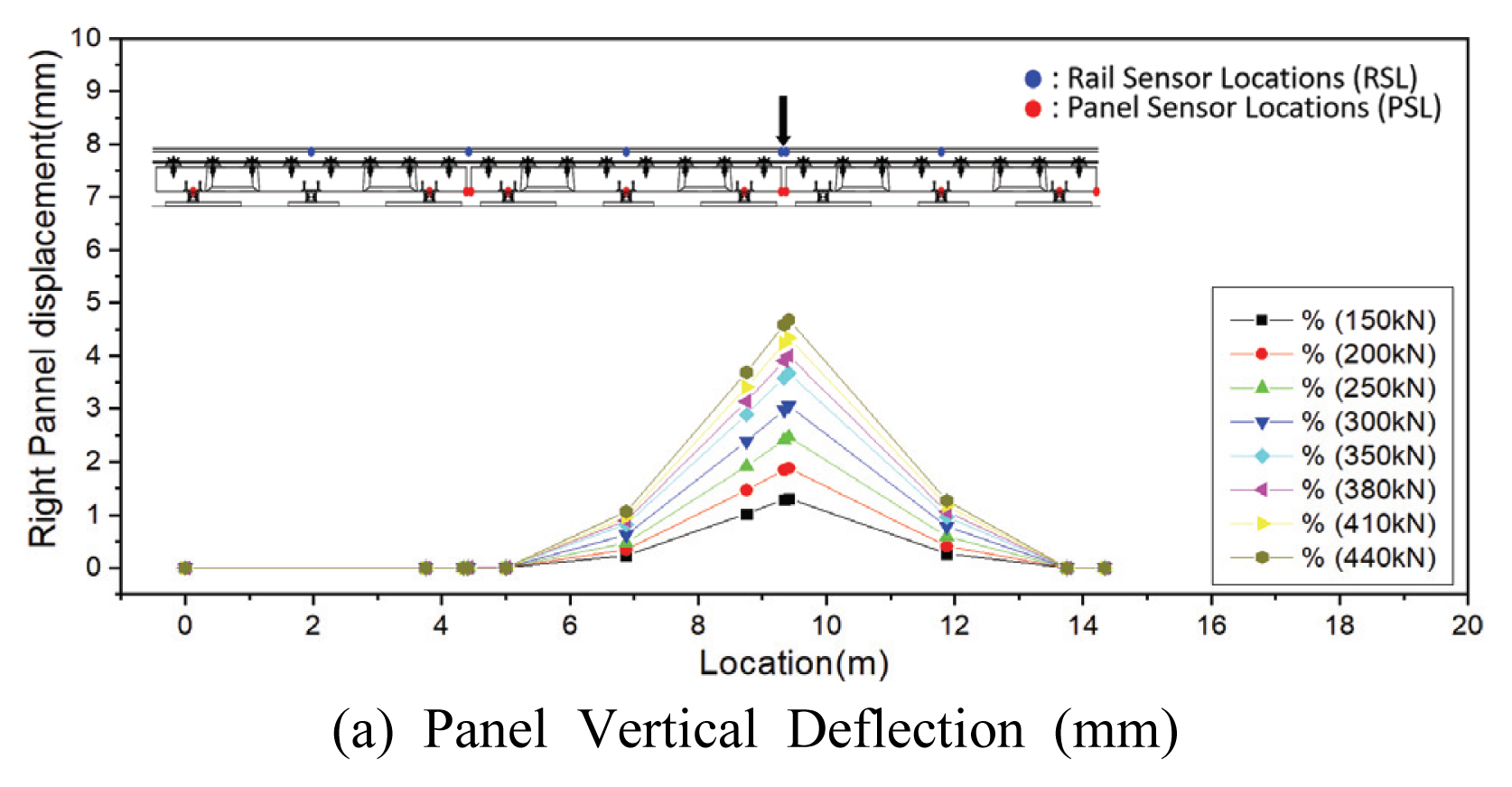
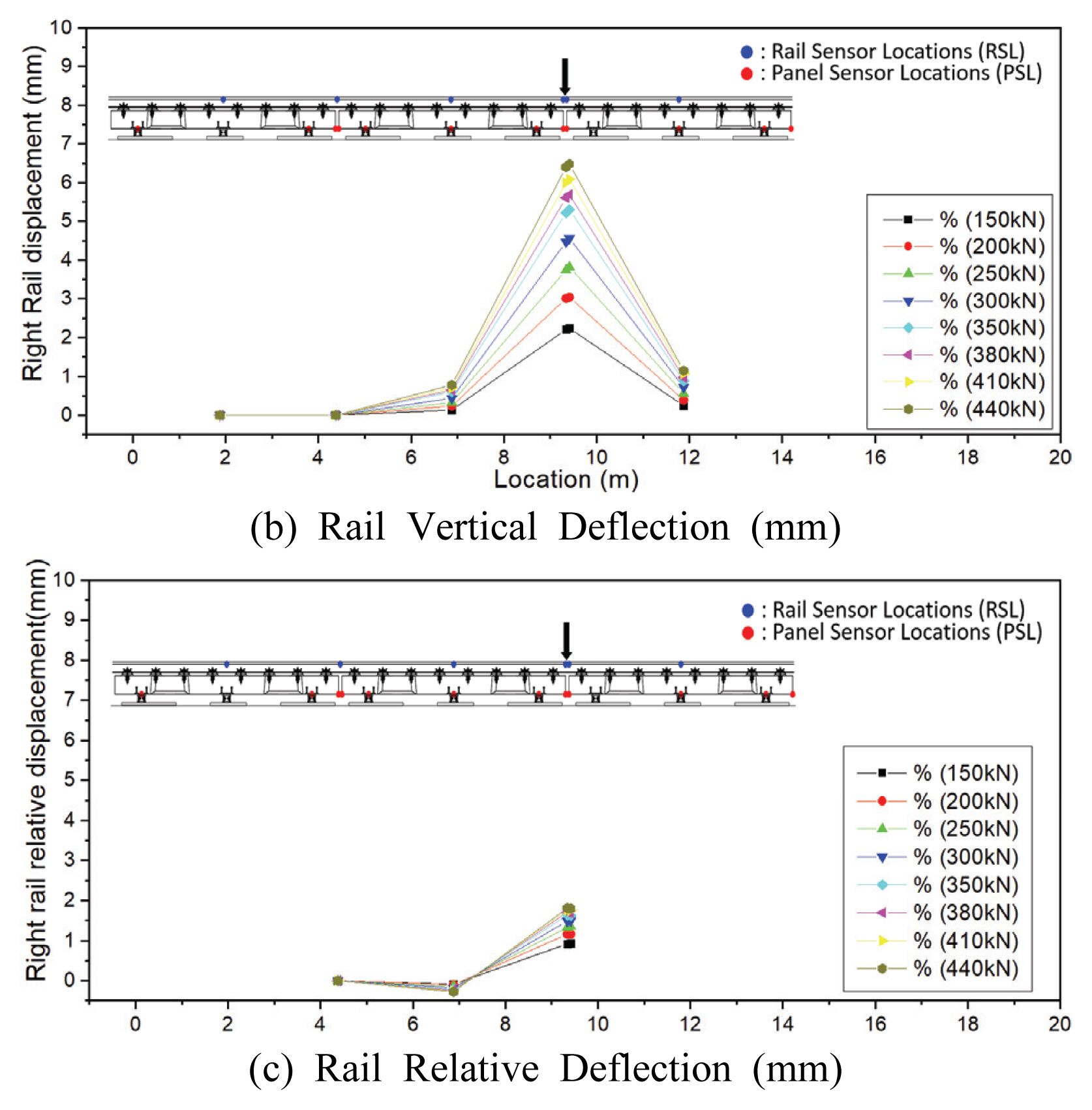
Fig. 11
Results of Rail Relative Deflection Measurement for 3 Slab Panel Assembly (Loading point on 2nd panel at 1/4 point)
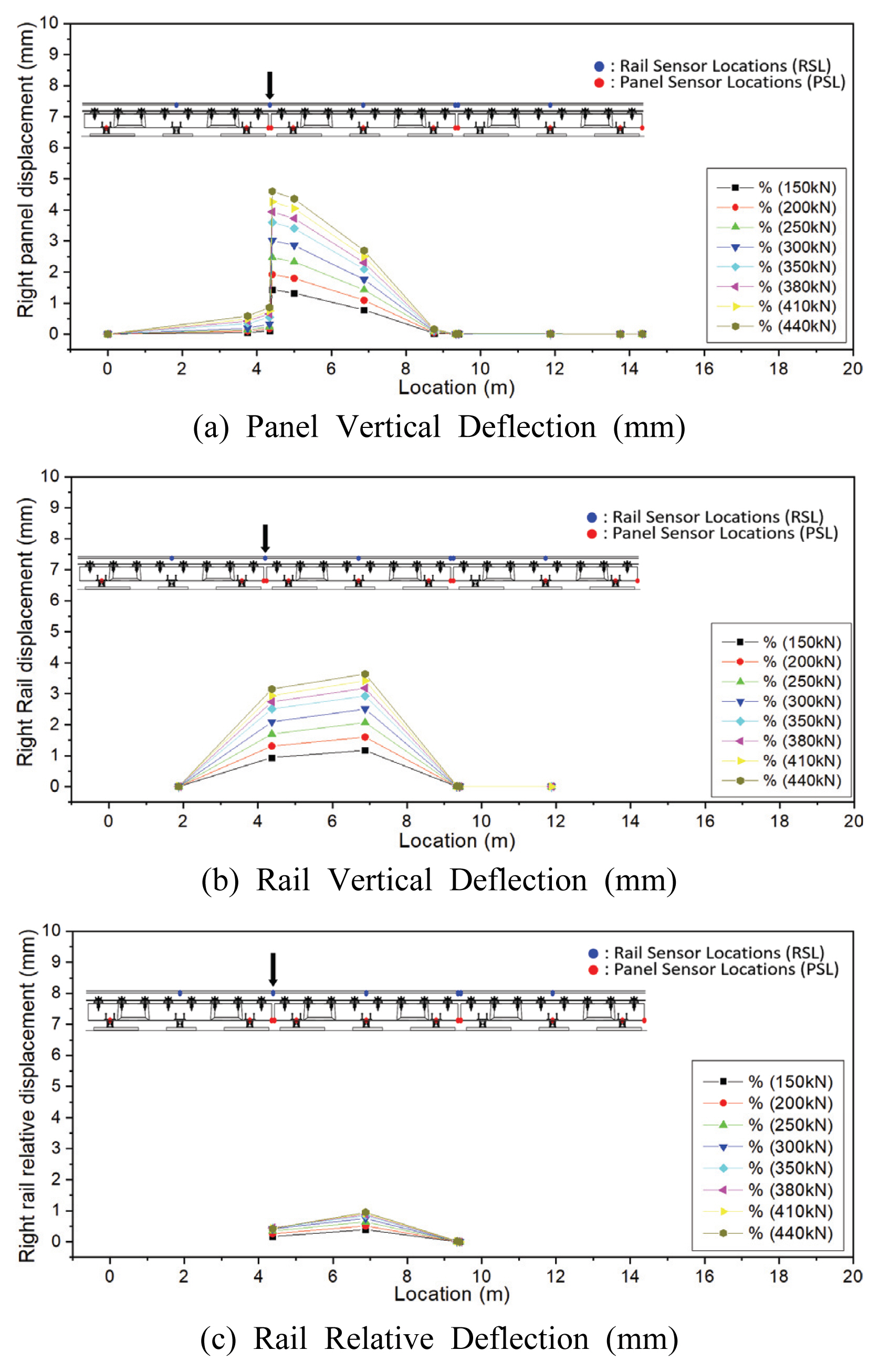
Fig. 12
Result of Right Rail Stress (MPa) Measurement for 3 Panel Assembly Test (center load weight at 2/4 point)
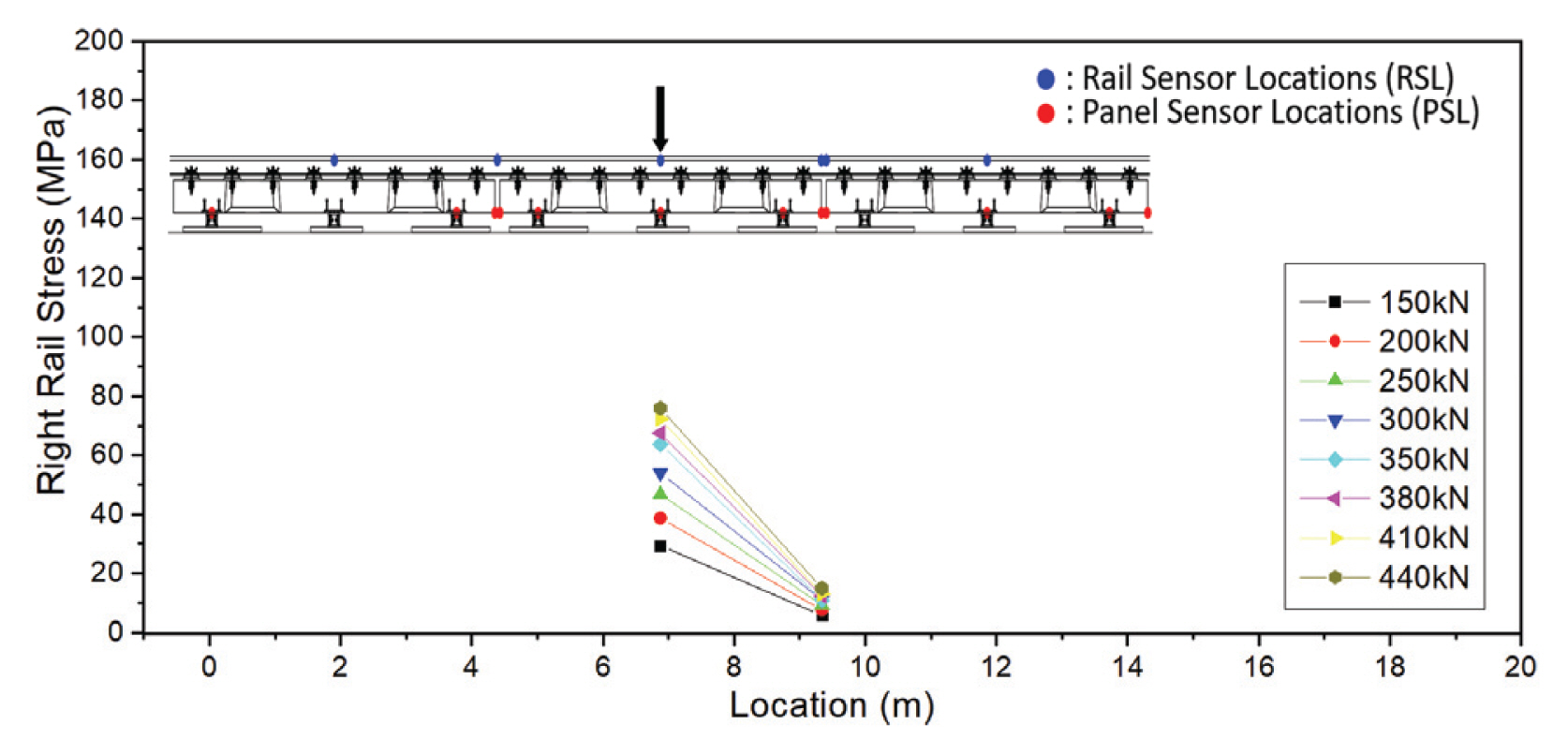
Table 1
Test of Assembly Precast Floating Slab Track
Table 2
Main Dimensions of Floating Track
Table 3
Static Load Test Point
Table 4
Dynamic Load Test Point
Table 5
Maximum Panel Vertical Deflection (1 panel under center point loading)
Table 6
Maximum Rail Deflection Measurement Result (1 panel under center point loading)
Table 7
Maximum Panel Vertical Deflection (3 panel under center point loading)
Table 8
Maximum Relative Rail Deflection of Load Test (3 panel Rails fastening assembly Test Body)
Table 9
Load Test Result of Maximum Rail Stress (3 panel Rail fastening assembly test specimen 2/4 point load weight)
Table 10
Comparison of Load Transfer Capacity between Loading Panel End and Adjacent Panel End
Table 11
Static, Dynamic and Fatigue Test Results of Prefabricated Floating Slab Track
References
Jang, SY, Ahn, MK, Choi, WI, and Park, MH (2011). Investigation of load transfer characteristics at slab joints in the floating slab track by equivalent shear spring model. Proceedings of 2011 Autumn Conference. Korean Society for Railway, p 2838-2843.

Jang, SY, and Yang, SC (2012) Assessment of train running safety, ride comfort and track serviceability at transition between floating slab track and conventional concrete track. Journal of the Korean Society for Railway, Vol. 15, No. 1, pp. 48-61.


Kang, YS, et al (2012). Performance improvement and maintenance technology development of high-speed railway systems - Next generation high speed rail technology development project. Final Report. Korea Railroad Research Institute, Ministry of Land, Infrastructure and Transport.

Kwon, SG, and Kim, JY (2018). Development of noise and vibration reduction technology for railway station structures. Railway Journal. The Korean Society for Railway, Vol. 21: No. 6, p 14-20.

Railway Technology Research Institute (RTRI) (2006). Design standards for railway structures and, commentary - Limit for displacement. Ministry of Land, Infrastructure, Transport and Tourism, Japan.

Wagner, HG (2002). Attenuation of transmission of vibrations and ground-borne noise by means of steel spring supported low-tuned floating track-beds. 2002 World Metro Symposium. Taipei.

- TOOLS
-
METRICS

-
- 1 Crossref
- 3,227 View
- 109 Download
- Related articles in KOSHAM
-
Evaluating Structural Performance of U-shaped Precast Concrete Modular Joints2023 December;23(6)
Experimental Study on Reducing the Risk of Wildland Fires by Prescribed Fire2021 April;21(2)
Experimental Study on Seismic Performance of Old Masonry Walls2020 December;20(6)









